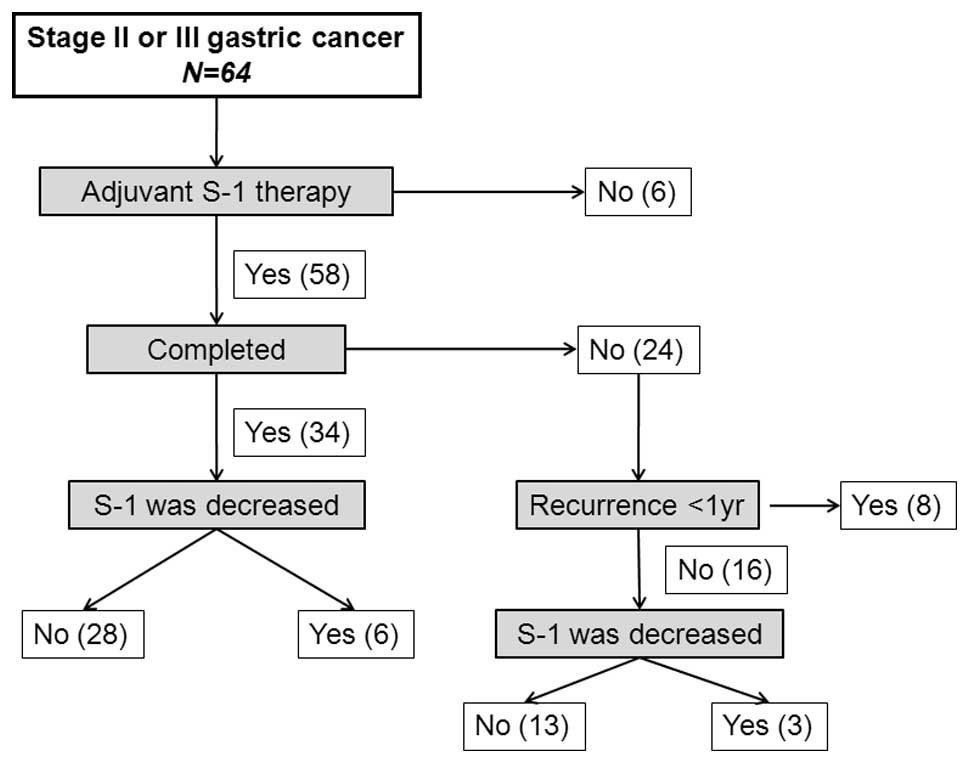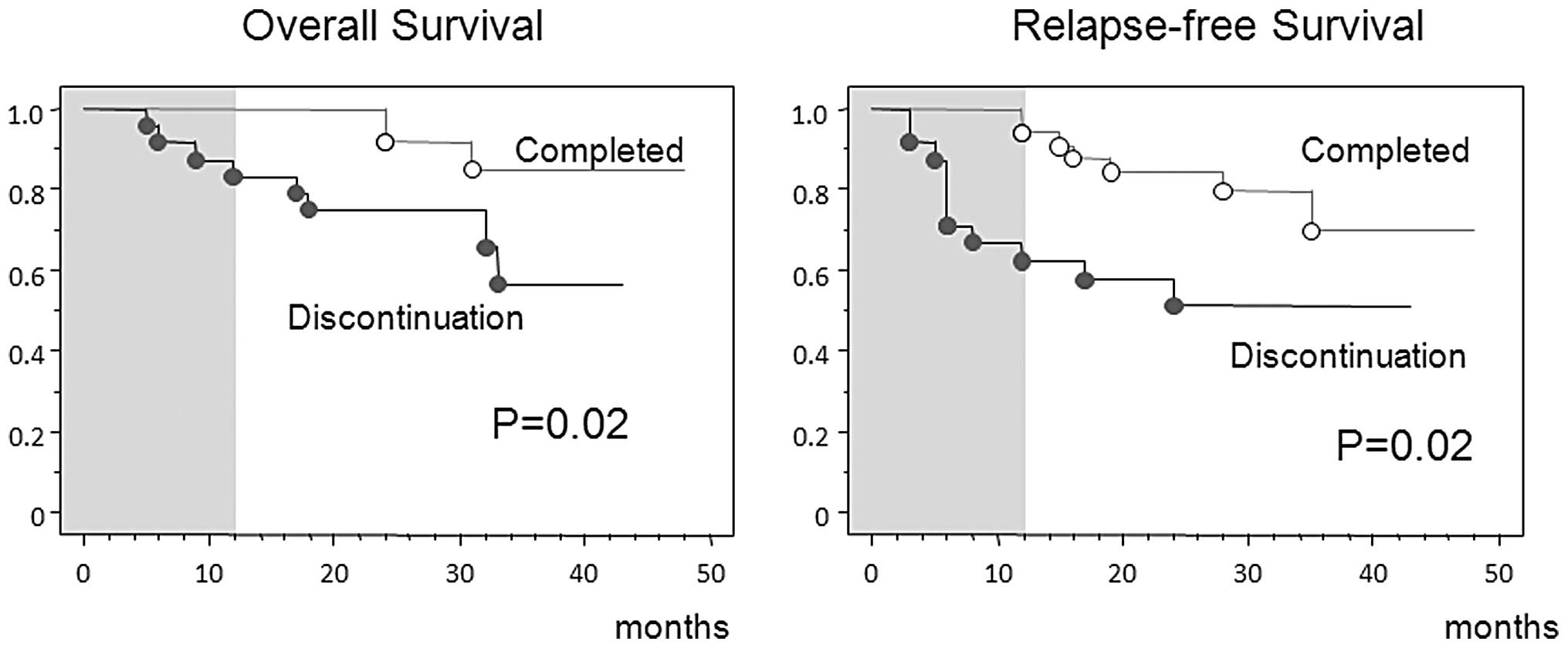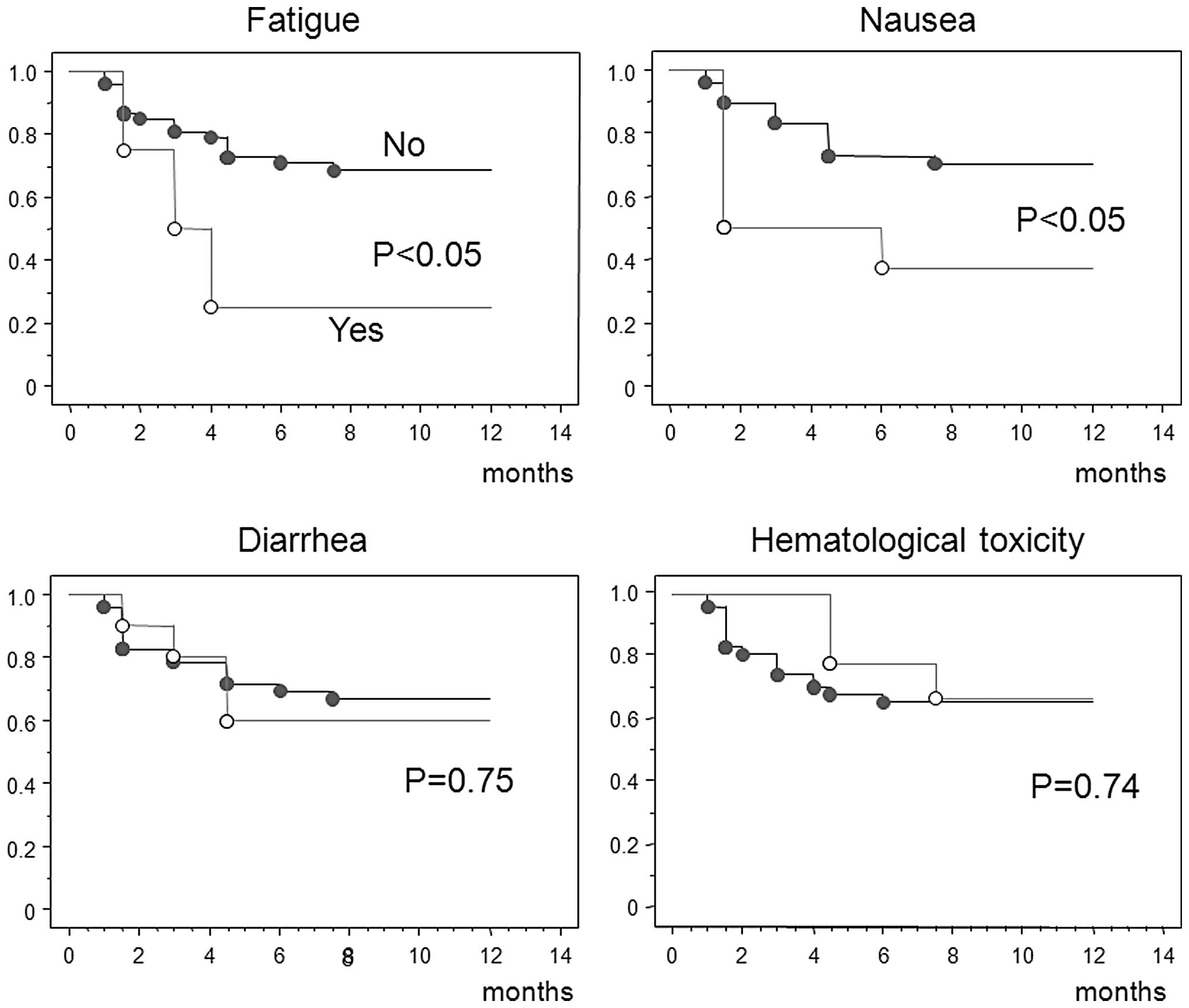Tolerability of adjuvant chemotherapy with S-1 after curative resection in patients with stage II/III gastric cancer
- Authors:
- Published online on: August 27, 2012 https://doi.org/10.3892/ol.2012.882
- Pages: 1135-1139
Abstract
Introduction
S-1 is an oral anticancer preparation composed of a mixture of tegafur [FT, a prodrug of 5-fluorouracil (5-FU)], 5-chloro-2,4-dihydroxypyridine (CDHP, a biochemical modulator that inhibits 5-FU biodegradation) and potassium oxonate (Oxo, added to reduce the gastrointestinal toxicity of 5-FU) (1–3). In the two registration phase II studies in Japan, the rate of response to treatment with S-1 alone exceeded 40% in patients with advanced or recurrent gastric cancer (4,5). The Japan Clinical Oncology Group (JCOG) conducted a randomized prospective controlled study to evaluate the efficacy of single-agent S-1 as adjuvant therapy for patients with stage II/III (Japanese Classification of Gastric Carcinoma, JCGC) (6) gastric cancer following curative D2 dissection (7). When the final analysis was performed in September 2006, 3-year overall survival (OS) was 80.5% for S-1 treated patients and 70.1% for patients who underwent surgery alone. The hazard ratio for death in S-1 treated patients was 0.68 (P=0.0024). The results of this trial demonstrated that adjuvant chemotherapy with S-1 for stage II/III gastric cancer is effective and suggested that this therapy should be adopted as the standard treatment following curative D2 gastric dissection (8).
To investigate the tolerability of adjuvant chemotherapy with S-1 for stage II/III gastric cancer following curative D2 dissection, we reviewed treatment outcomes in patients receiving this adjuvant therapy.
Materials and methods
Patients
Between August 2007 and July 2010, 283 patients underwent gastrectomy for adenocarcinoma of the stomach with curative intent at the National Defense Medical College Hospital (Tokorozawa, Saitama, Japan). Of these, 64 patients (41–84 years old) had pathological stage II/III disease according to the JCGC (6). All patients were informed of the efficacy of the adjuvant chemotherapy trial of S-1 for gastric cancer (ACTS-GC) and provided their consent to the study (7).
Treatment regimen
S-1 was orally administered twice daily for 4 weeks, followed by a 2-week rest. This schedule was repeated every 6 weeks for 12 months until tumor recurrence, observation of unacceptable toxicity levels or refusal by the patient to undergo further treatment. Dosages were assigned according to the patient body surface area: <1.25 m2, 80 mg/day; 1.25–1.5 m2, 100 mg/day; and ≥1.5 m2, 120 mg/day. Dosage modification and treatment interruption were performed according to the protocol in the registration trial (5,7). The dose or treatment schedule was modified at the physician’s discretion according to the toxicity profiles. In principle, if patients had hematological toxic effects of grade 3 or 4 or non-hematological toxic effects of ≥ grade 2, their daily dose was reduced and/or their schedule was changed from a 4-week administration followed by a 2-week rest, to a 2-week administration followed by a 1-week rest.
Measures
If no gross residual disease was evident at the time of surgery and the resection margins were tumor-free on histological examination, surgery was considered curative. Pathological findings in gastric cancer patients were described on the basis of the JCGC (6). Adverse reactions were evaluated according to the common toxicity criteria of the National Cancer Institute, version 3.0 (http://ctep.cancer.gov).
OS was measured from the date of resection to the date of mortality from any cause. Relapse-free survival was measured from the date of resection to the date when relapse was evident by computed tomography, gastrointestinal endoscopic examination, abdominal ultrasonography, upper gastrointestinal series and/or positron emission tomography. Data for the patients who survived were censored in our survival analyses. The medication completion rate was measured from the date of treatment commencement to the date of treatment discontinuation. Data for patients in whom S-1 treatment was discontinued due to tumor recurrence or mortality were censored in this analysis. All patients were observed at our hospital or outpatient clinic at 2- to 4-week intervals up to 12 months after surgery, 3- to 4-month intervals during the 2 years of the study and every 6 or 12 months thereafter for 3 years.
Statistical analysis
Statistical calculations were performed using StatView version 5.0 (SAS Institute, Inc., Cary, NC, USA). Data are expressed as the means ± SEM. Statistical analyses were performed using the Mann-Whitney U test or Chi-square test with Fisher’s exact test, as appropriate. Survival and medication completion rates were calculated using the Kaplan-Meier method and the significance of the difference was determined by a log-rank test. P<0.05 was considered to indicate a statistically significant result.
Results
Of the 64 patients included in the study, 6 refused adjuvant therapy with S-1 due to age (n=4) or financial concerns (n=2). The remaining 58 patients received S-1 within 8 weeks of surgery (Fig. 1). Twenty-four patients (41.3%) discontinued treatment within 12 months as a result of disease relapse (n=8) and intolerable adverse events (n=16). The S-1 dose was decreased in 9 of the 58 patients (15.5%). Of the 34 patients who underwent treatment for 12 months, the S-1 dose was decreased in 6 (17.6%), and of the 24 patients who discontinued treatment, the S-1 dose was decreased in 3 (12.5%). Among the 58 patients who received S-1 therapy, treatment was continued for at least 3 months in 49 patients (84.5%), at least 6 months in 45 patients (77.6%), at least 9 months in 37 patients (63.8%) and 12 months in 34 patients (58.6%).
Demographic and clinicopathological data of patients are shown in Table I. Patients who discontinued S-1 treatment within 12 months were older than those who completed 12 months of adjuvant therapy. However, no differences were observed in tumor stage and surgery type (gastrectomy, reconstruction or resection of other organs) between the two groups. Patients who completed 12 months of adjuvant therapy with S-1 were more frequently treated by senior doctors (>15 years of experience). More favorable outcomes in OS and relapse-free survival were observed in these patients than in those who discontinued treatment (Fig. 2).
Table II summarizes the data concerning the adverse reactions observed among the 58 patients in this study. No patient had ≥ grade 4 adverse events; however, 3 patients had grade 3 leukopenia. In terms of non-hematological adverse events, grade 3 anorexia was observed in 1 patient and grade 3 diarrhea was observed in 1 patient. The most frequent cause of S-1 treatment discontinuation was tumor recurrence. Non-hematological adverse events such as diarrhea and nausea were also associated with treatment discontinuation (Table III). Fig. 3 shows the medication completion rates. S-1 treatment time was significantly shorter in patients who experienced fatigue or nausea as an adverse event, whereas diarrhea and hematological toxicity did not significantly affect the period of treatment.
Table IIAdverse reactions to adjuvant therapy with S-1 among the 58 patients included in this study. |
Discussion
This study demonstrated that patients who completed 12 months of adjuvant therapy with S-1 were younger and more frequently treated by doctors with >15 years of experience than those who did not. Non-hematological adverse events such as nausea and fatigue were frequent causes of S-1 treatment discontinuation. Adverse events of ≥ grade 3 were significant causes of treatment discontinuation in a small number of patients.
In a postmarketing survey of S-1 (9), including 3,294 patients with advanced or recurrent gastric cancer, the incidence of adverse reactions following administration of the drug at the usual dose level according to the patient body surface area was 74.1%, which was approximately equal to that obtained in premarketing trials. The major reasons for drug discontinuation during the first and second course of therapy were exacerbation of symptoms (43%) and adverse drug reactions (33%). Therefore, to facilitate S-1 administration for prolonged time periods, the incidence of adverse reactions should be reduced. To accomplish this goal, several regimens have been established (10). Kimura et al developed a new S-1 dosing regimen in which S-1 is administered for a 2-week period separated by 1-week drug-free intervals, as adverse reactions due to S-1 therapy begin to appear 2–3 weeks after initial dosing (11). Sakuma et al also proposed alternate-day treatment with S-1 as a strategy for reducing toxicity, although the total dose of this regimen was 75% that of standard treatment (12). Both regimens decreased the incidence of adverse reactions and improved treatment compliance when compared with the conventional 4-week administration followed by a 2-week rest regimen.
In the ACTS-GC trial, 143 of 517 (27.7%) patients discontinued S-1 treatment due to adverse events, which was consistent with our results (27.6%). Only 5% patients in the ACTS-GC trial had metastasis or relapse of gastric cancer. Our study, which includes potentially more cases of advanced stage disease than the ACTS-GC trial, involved relatively shorter time periods of the treatment than the ACTS-GC trial.
Patients who experienced fatigue or nausea as adverse events continued S-1 treatment for significantly shorter time periods. However, diarrhea and hematological toxicity did not significantly affect the treatment period. Following gastrectomy, fatigue and gastrointestinal symptoms such as nausea and appetite loss, even of ≤ grade 2, appeared to have a major impact on treatment compliance.
In conclusion, the completion rate of S-1 treatment did not depend on the type of surgical procedures, i.e., gastrectomy, reconstruction or resection of other organs. Fatigue and gastrointestinal symptoms affected the period of treatment continuation. In addition, patients who completed 12 months of adjuvant therapy with S-1 were more frequently treated by doctors with ≥15 years of experience. Thus, to facilitate the continuation of adjuvant therapy with S-1, patients and doctors must be made completely aware of the issues of toxicity, compliance and efficacy associated with this therapy.













